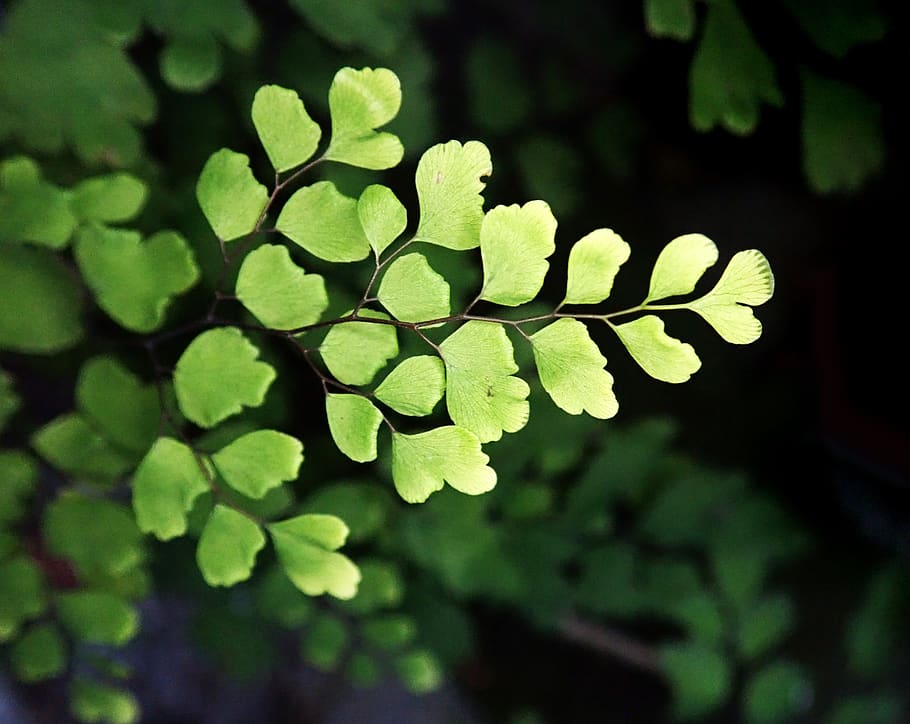Ah, the maidenhair fern.
This plant is divisive. Some say it’s fairly easy to care for, and others have gone through several of them before finally giving up completely. But the truth is, anyone can learn how to care for a maidenhair fern!
For the most part, this plant has a reputation for being fussy, and your luck with maidenhair ferns probably has a lot to do with the light and humidity in your home and how diligent you are with the watering can.
Most people seem to experience a steep learning curve with these plants (I sure did!). If you’re up for a challenge or simply just fall in love with this plant’s lacy fronds, we’ve got tips for you.
About the Maidenhair Fern
Divisive or not, this plant is definitely beautiful. Characterized by its delicate, hand-shaped fronds, this plant actually grows natively in North America, unlike most houseplants.
The maidenhair fern belongs to the genus Adiantum, which is a Greek word for “unwetted.” This refers to the waxy, water-repellant coating on the leaves. There are 200 species of maidenhair ferns that grow on all continents except Antarctica, mostly in temperature regions such as the American southwest, the eastern coast, and even as far west as the Rocky Mountains.
Some of the most popular species kept as houseplants are the northern, southern, and western maidenhair fern. (Easy to remember, right?) Its stems have been used for dyes and weaving, but most commonly as medicine.
Here are our top tips for how to care for a maidenhair fern!
How to Care for a Maidenhair Fern
Soil and Potting
Maidenhair ferns are pretty particular about their soil and prefer a rich, slightly alkaline mix with plenty of compost. We recommend buying a high quality indoor potting soil and mixing a little compost in.
Use a pot with drainage holes, and make sure the pot is only a little larger than the root ball. Avoid terracotta pots, because these can cause the soil to dry out too quickly. Plastic or fully-glazed ceramic works best. Double potting is also a good idea so you can easily remove the plant from its pot and water in the sink.
Also, these plants don’t like to be repotted, so repot only when the plant is very root-wrapped, and do this in the spring when it’s about to experience a growth spurt.
Light
Direct sunlight is a no-no and will scorch the fern’s delicate leaves. Maidenhair ferns like partial shade, so find a nice shady corner where the plant casts a soft shadow at most. A far corner in a bright room works best, or a corner near a window in a north-facing room is also a good choice.
Water
Maidenhair ferns are water lovers, so you’ll want to keep the soil evenly moist. If you let the soil dry out even a little, the leaves will get crispy almost immediately. You don’t want soggy soil, but the surface should be moist to the touch.
Check the plant every day and water when the top of the soil starts to feel slightly dry. Put the plant in a sink if you can and water thoroughly. Be careful not to pour water onto the delicate leaves, because this can break them. Let the pot drain before placing the plant back in its spot.
Some people also do well with the bottom watering method. To do this, place your pot in a deep tray full of water, and keep the water topped off. The soil will absorb water from the bottom drainage holes.
Humidity and Temperature
These plants like high humidity. Keep your maidenhair fern well away from vents and drafts, heaters, or anything that expels dry air, or you’ll wind up with a dried-out pot of leaves in no time!
Unless you live in a very humid area, you’ll almost certainly want to set it up with its own personal humidifier and/or pebble tray to keep it moist.
Temperatures around 70 degrees Fahrenheit work best, but never let it drop below 60 degrees Fahrenheit, or it will kill your fern!
Fertilizer
You’ll need to water this plant often, which can flush nutrients from the soil, so you’ll want to fertilizer regularly as well. I like to use Indoor Plant Food each time I water, or even every other time.
Propagation
I wouldn’t try to take cuttings of this plant, but you can propagate by separating the root ball into smaller plants. When you repot, gently cut or pull the root ball apart into smaller plants with at least a couple stems each. Then, repot them and care for them as normal.
Since this is a fern, you can also propagate using spores! (Fun fact: ferns produce spores, not seeds.)

If you start to see little brown spots underneath the leaves, you can cut off a few fronds and sandwich them between two slips of paper for a few days until the spores drop off the leaves. Then, spread the spores over moist soil in a pot and cover the top with cling wrap. In a few weeks, you’ll new plants starting to grow!
Troubleshooting
Here are the most common issues you’ll see when you’re learning how to care for maidenhair ferns.
Yellowing leaves: Your plant is probably getting too little light (but increase carefully to avoid scorching)
Slow growth: Too little light.
Dry leaves: Your plant is too dry. Try increasing humidity with a humidifier or pebble tray. Check the soil as well. If it feels at all dry to the touch, water immediately!
Note: If you accidentally let the plant dry out, you might be able to revive it. Remove any dead leads and give the soil a good soaking. The plant may start to grow new leaves to replace the dead ones within a few months.
Dark brown leaves: Minerals in the water may be causing problems, so switch to distilled water (or leave tap water out overnight so the chlorine can evaporate.) Also, make sure your plant isn’t getting direct sunlight.
Maidenhair ferns can be challenging, but they’re so beautiful that it’s well worth learning to care for them! Once you get the light and water right, you’ll be well on your way to owning a beautiful, thriving fern that brings a touch of the temperate rainforests to your space.




